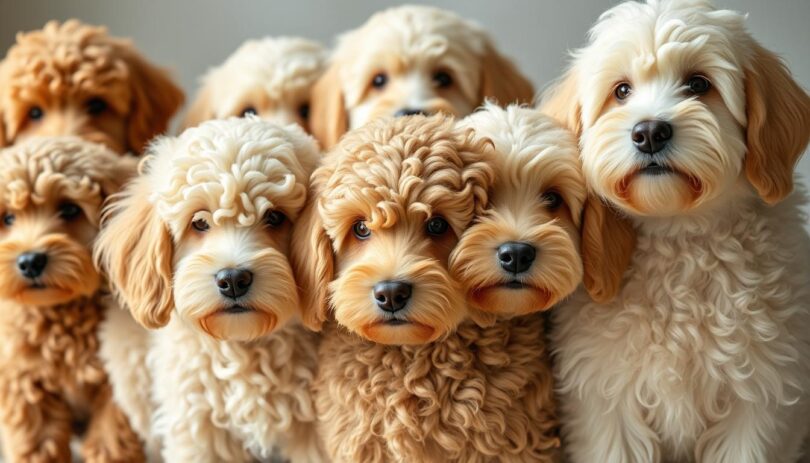Imagine bringing home a fluffy companion, only to find stray hairs on your couch weeks later. For many pet lovers, this scenario sparks a critical question: What can I expect from my new family member’s grooming needs? Goldendoodles, with their playful personalities and wavy coats, have become a favorite among dog owners. But their mixed heritage creates unique challenges—and opportunities.
While these crossbreeds inherit low-shedding traits from poodles, golden retriever genes add unpredictability. A puppy’s coat might lean curly like a poodle’s or straighten over time. This variability means no two dogs are exactly alike—and neither are their grooming routines.
Understanding factors like genetics and coat texture helps owners manage expectations. Regular brushing, professional trims, and allergy-friendly practices can make life easier for everyone. This guide breaks down the science behind shedding while offering actionable tips tailored to your pet’s needs.
You’ll learn how furnishings (those signature wispy face hairs) impact maintenance and why even “hypoallergenic” breeds aren’t foolproof. Let’s explore how to keep your furry friend happy—and your home hair-free.
Understanding Goldendoodle Shedding: Genetics and Coat Types
The secret to a Goldendoodle’s coat lies in its genetic blueprint. These crossbreeds inherit characteristics from both golden retriever and poodle parents, creating unique combinations that influence grooming needs. While some puppies develop wavy fur, others may display tighter curls as they mature.
Genetics and Inheritance From Parent Breeds
Golden retrievers contribute a double-layered coat designed for outdoor activities, which sheds seasonally. Poodles, however, possess a single-layer curly coat that traps loose hair. This genetic mix means Goldendoodles often fall somewhere between these extremes.
Reputable breeders sometimes use genetic testing to predict coat behavior. These tests analyze dominant traits from each parent breed, helping families prepare for specific care routines. For example, a puppy with more poodle-like genes might require less frequent brushing.
Differences Between Golden Retriever and Poodle Coats
The golden retriever’s double coat consists of a dense underlayer and water-resistant topcoat. This design sheds heavily during seasonal changes. Poodles lack this undercoat, making their hair less likely to drop onto furniture.
When these two dog breeds combine, the resulting coat type becomes unpredictable. Some Goldendoodles inherit the poodle parent’s low-shedding traits, while others retain the retriever’s thicker fur. Regular grooming adapts to these variations, ensuring healthy skin and minimal stray hairs.
Do Goldendoodles Shed? Exploring the Impact of Furnishings
Ever notice how some Goldendoodles sport scruffy mustaches or expressive eyebrows? These facial features, called furnishings, aren’t just adorable—they’re clues about shedding tendencies. Inherited from their poodle lineage, furnishings signal a curly or wavy coat that traps loose fur.
The Role of Furnishings in Coat Appearance
Furnishings refer to the longer hairs around the muzzle, chin, and eyebrows. Dogs with these traits often have single-layer coats similar to their poodle parent. This coat type sheds less because loose fur gets caught in the curls instead of falling out. Breeders note that puppies with prominent furnishings at 8-12 weeks usually develop low-shedding adult coats.
How an “Improper Coat” Can Influence Shedding
Goldendoodles lacking furnishings may have an “improper coat,” which leans toward the golden retriever’s double coat structure. This fur type sheds more seasonally, releasing higher amounts of hair. While no coat is truly maintenance-free, understanding these genetic markers helps owners anticipate grooming needs. For example, a furnished coat requires weekly brushing, whereas an improper coat might need daily attention during shedding seasons.
Grooming and Maintenance Tips for a Healthy Coat
A well-maintained coat isn’t just about looks—it’s your pet’s first defense against skin issues and tangles. Proper care combines daily habits with seasonal adjustments tailored to your dog’s unique fur texture.
Daily Brushing and Regular Grooming Practices
Brushing your companion daily removes loose hair before it hits your floors. Use a slicker brush for curly coats or a pin brush for wavy textures. This routine prevents mats and distributes natural oils for a shiny appearance.
Professional groomers recommend starting sessions early to acclimate puppies to handling. Focus on sensitive areas like ears and paws. Keep sessions short—5 minutes daily beats hour-long struggles weekly.
Seasonal Grooming and Professional Care Strategies
Schedule trims every 6-8 weeks during warmer months. Summer cuts improve airflow, while winter trims maintain insulation. Professionals can spot hidden issues like hot spots or parasites during these visits.
Nutrition plays a starring role in coat health. Foods rich in omega-3s, like salmon or flaxseed, strengthen hair follicles. For inspiration on balanced diets, explore our red golden retriever nutrition guide.
Managing Allergen Concerns While Enjoying Your Goldendoodle
Many families welcome these dogs believing they’re allergy-proof—only to discover sniffles and sneezes later. While no dog is 100% hypoallergenic, smart strategies can help balance pet joy with health needs.
Understanding Hypoallergenic Myths
The term “hypoallergenic” suggests minimal allergy risks, but dander and saliva proteins still exist. Even dogs that shed less distribute microscopic allergens through licking or skin flakes. A 2022 study found 30% of allergy sufferers react to low-shedding breeds.
Practical Solutions to Reduce Dander and Allergens
Start by vacuuming twice weekly with HEPA filters. Wipe paws after walks to limit outdoor allergens entering the house. Bathing your pet every 3 weeks reduces dander buildup.
Air purifiers near sleeping areas trap airborne particles effectively. One owner reported 40% fewer symptoms after using one in their living room. Grooming tools like de-shedding brushes also minimize loose fur around the house.
Remember: Consistency matters. Combine these steps with regular vet checkups to address skin conditions that increase shedding. Your efforts create a healthier space for people and pets alike.
Wrapping Up Your Goldendoodle Shedding Journey
Navigating your companion’s coat needs becomes simpler when you embrace their unique genetic makeup. These crossbreeds blend traits from their poodle and retriever parents, creating varied hair textures that demand personalized care. Whether your pet sports tight curls or wavy strands, understanding their inherited traits helps you stay ahead of shedding.
Regular brushing and professional grooming form the foundation of coat health. Pair these habits with seasonal trims to manage loose hair effectively. Allergy-conscious households benefit from vacuuming routines and air purifiers, reducing dander accumulation without sacrificing cuddle time.
Remember: every hybrid dog evolves differently. Puppies might shift coat types as they mature, requiring adaptable strategies. Schedule vet checkups to address skin conditions early and maintain nutritional balance for optimal fur quality.
With consistent care, you’ll minimize stray hairs while nurturing a thriving bond. Embrace the journey—your efforts ensure a cleaner home and a happier, healthier companion ready for years of adventures.
FAQ
Are Goldendoodles hypoallergenic?
No dog is truly hypoallergenic, but Goldendoodles often produce less dander than Golden Retrievers due to their Poodle ancestry. Those with tighter curls or furnishings (facial hair) typically shed less, making them better suited for allergy-prone households.
How often should I groom my Goldendoodle to minimize loose hair?
Brush your pet 3–4 times weekly using a slicker brush or comb. Professional grooming every 6–8 weeks helps trim mats and manage seasonal shedding. Dogs with straighter coats may require more frequent sessions than curly-coated ones.
Do F1B Goldendoodles shed less than F1 hybrids?
Yes. F1B mixes (75% Poodle, 25% Golden Retriever) usually inherit more Poodle coat traits, reducing shedding. F1 hybrids (50/50) have higher chances of retaining the Golden Retriever’s double coat, which sheds moderately year-round.
Can diet affect how much my dog sheds?
Absolutely. High-quality foods rich in omega-3 fatty acids support skin health and reduce excessive shedding. Avoid fillers like corn or soy, which can trigger allergies and worsen coat problems.










Leave a Comment